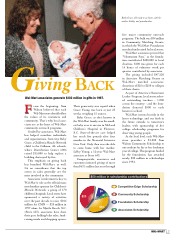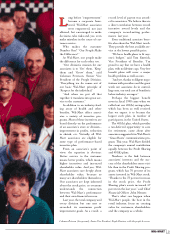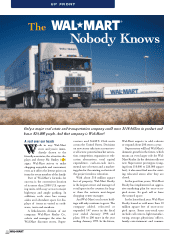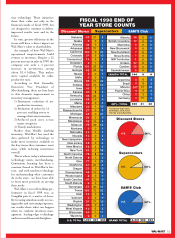Walmart 1998 Annual Report Download - page 16
Download and view the complete annual report
Please find page 16 of the 1998 Walmart annual report below. You can navigate through the pages in the report by either clicking on the pages listed below, or by using the keyword search tool below to find specific information within the annual report.
hen Wal-Mart turned
to Supercenters - larger
than traditional dis-
count stores, with a full-service
grocery department - as a key vehi-
cle for future growth, some investors
wondered how the addition of tradi-
tional grocery store items would
affect the division’s
performance.
Some also won-
dered whether
consumers would
be willing to shop
for food and gener-
al merchandise in
the same place.
Those questions
have been an-
swered to the
benefit of Wal-Mart
shareholders.
Wal-Mart Discount Stores
already carry many of the items
that a typical supermarket sells,
such as household cleansers, paper
goods, soft drinks, snacks and
health and beauty care items.
When we add a grocery section to
a regular store, creating a
Supercenter, it is a natural exten-
sion of the concept. As we expect-
ed, shoppers responded enthusias-
tically to the one-stop convenience.
Supercenters will represent more
than 20 million square feet of our
new retail space this year. We also
expect them to provide half of our
earnings growth over the next
three to five years.
Wal-Mart Discount Stores, the
core of our business, are also a key
component of our earnings engine.
They delivered improved results
this year through execution and
merchandising initiatives. Our
inventory reduction efforts have
provided sustainable margin bene-
fits while allowing us to continue to
roll back prices. This means
fresher merchandise, better
sales and improved prof-
its for our shareholders.
Along with serving as
a primary driver of
growth, Supercenters have
been an important source
of the continuous learning
that is central to the Wal-
Mart Way of doing
business. By “data-mining“
the massive supply of infor-
mation on customer shopping
habits that our information
technology provides, we have
been able to refine our store lay-
outs and design, so that new and
remodeled stores more effectively
serve customers.
For another example, once
Wal-Mart went seriously into the
food business, which is a $450 bil-
lion market in the U.S., we quickly
learned the ins and outs of making
regional perishable food distribu-
tion as efficient as possible. As one
analyst wrote in October 1997:
Combined with the merchandising
savvy of Wal-Mart’s team of food mer-
chants, regional perishable food
distribution and related centralized buy-
ing are enabling Wal-Mart to get a leg up
on some of the competition in terms of both
merchandising power and value.
SAM’S Club, the largest domes-
tic warehouse club operation, is
another major source of earnings
for Wal-Mart.
With 443 units and attractive
returns, SAM’S already is a signif-
icant contributor to the overall
company. On top of that, under
SAM’S new President, Mark
Hansen, the division is introducing
important enhancements in prod-
ucts and services this year.
Wal-Mart plans to remodel about
70 SAM’S Club units in fiscal 1999,
expand a large number of fresh
departments and add about 10 new
units.
16
Supercenters have been
an important source of the
continuous learning that is
central to the Wal-Mart Way.
By "data-mining" the
information on customer
shopping habits that our
technology provides, we have
been able to refine store
layouts and design.
SHORT HAND
Wal-Mart, Supercenters and SAM’S Club drive Wal-Mart’s growth -
and refinements in merchandising are revving the engine.
COVER REPORT: MAKING THE GRADE
W
W
W
























